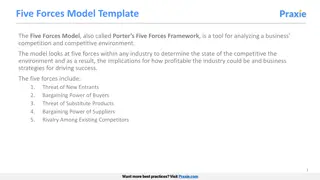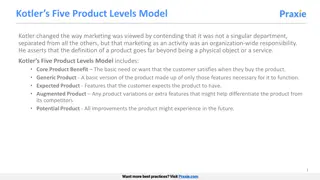Using the Five Case Model for Effective Business Case Development
The Five Case Model (5CM) is a framework used to assess projects from various perspectives to ensure strategic necessity, economic and social desirability, commercial viability, affordability, and practical deliverability. This model strengthens project scoping, planning, risk assessment, and benefits realization. International best practices and infrastructure business cases are emphasized, aligning with the G20 Principles and supporting sustainable development goals. The 5CM methodology advances social and environmental sustainability by promoting inclusive economic growth, essential service delivery, productivity, resilience to climate change, and low-impact infrastructure.
Uploaded on Jul 19, 2024 | 0 Views
Download Presentation

Please find below an Image/Link to download the presentation.
The content on the website is provided AS IS for your information and personal use only. It may not be sold, licensed, or shared on other websites without obtaining consent from the author. Download presentation by click this link. If you encounter any issues during the download, it is possible that the publisher has removed the file from their server.
E N D
Presentation Transcript
Using the Five Case Model to Develop an Outline Business Case Presented by: Abdul Oladapo (Portfolio Management Lead) David Wright (Senior Adviser PPP/Project Finance) 24 March 2021
Background Policies, strategies, programmes and projects will only achieve their objectives and deliver benefits if they have been scoped robustly and planned realistically from the outset, and if the associated risks are identified and taken into account. The Five Case Model (5CM) for business cases looks at a project from five perspectives (each of which forms an individual case ), asking: The Strategic Case - Is the project strategically necessary? The Economic Case - Is the project economically and socially desirable? The Commercial Case - Is the project commercially viable? The Financial Case - Is the project affordable? The Management Case - Can the project be practically delivered?
International Best Practice Infrastructure Business Case: International Guidance This Guidance has been produced as part of a Global Infrastructure Programme sponsored by the UK s Prosperity Fund. The Global Infrastructure Programme is a cross-government United Kingdom programme delivered by the Foreign, Commonwealth and Development Office, the Infrastructure and Projects Authority, and the former Department for Business Energy and Industrial Strategy. The programme aims to facilitate the provision of sustainable and resilient infrastructure as a critical enabler for economic development in middle-income countries.
Use of the 5CM Methodology The 5CM methodology is gaining worldwide recognition because it: reflects the G20 Principles for the Infrastructure Project Preparation Phase (the G20 Principles ) these require infrastructure business cases to be written and assessed against project rationale, options appraisal, commercial viability, long term affordability and deliverability supports the G20 s recognition of the importance of quality infrastructure in advancing sustainable development goals (see next slide) Countries adopting the 5CM methodology can be confident they are applying international best practice in line with the expectations of the international community, including the MDBs
Use of the 5CM Methodology Advancing SDGs 5CM supports the United Nations Sustainable Development Goals, in particular: supporting social sustainability: good infrastructure design, planning and delivery contributes to inclusive economic growth, supporting essential service delivery, increasing productivity and enabling citizens to access better jobs and more profitable markets supporting environmental sustainability: with rapid environmental change, decision- makers must ensure infrastructure is both resilient to climate change and natural disasters, and is low-impact by utilising best practices, latest technologies and sustainable materials UKNIAF has developed a tool to help in determining the contributions that a project can make to meeting the above goals
UKNIAF PGESI & Climate Change Framework The Poverty, Gender and Social Inclusion and Climate Change (PGESI & CC) tool captures UKNIAF's Project Screening criteria It is based on the well-known international standards used by infrastructure investors for gender and climate smart investing, such as the Development Impact and Environmental & Social (E&S) risk due diligence framework of the CDC Group, the IFC s Performance Standards, and the 2X Criteria developed by the 2X Challenge initiative for gender-smart investing Used by the UKNIAF team to engage with the government and with lenders. It shows how the PGESI & CC criteria can be easily taken into consideration when assessing the commercial requirements of a potential investment, recognising that the two are not mutually exclusive An excel tool and accompanying slides together form the Framework
Using the PGESI & Climate Change Framework The Excel Tool that forms part of this Framework is structured in the five tabs sets below. UKNIAF intends to engage its institutional partners using the Excel tool, focusing on building capacity of the government. TAB 1: Guidance Note TAB 2: Scoring Methodology TAB 3: PGESI & CC Screening Tools TAB 4: Summary Notes TAB 5: Appendices A. C. B. E&S Risk Assessment Poverty, Gender and Inclusion Climate Change Mitigation / Adaptation
Adaptability of 5CM It may be used by any country around the world irrespective of its legal or governmental system (civil or common law) The 5CM can easily be adapted for in-country use, building on existing practice The 5CM is suitable for every type of infrastructure project and programme, whether economic (such as transport or telecommunications environmental (such as power or waste management) social (such as education, health or housing) It is scalable so that it can be applied proportionately to smaller sub-national projects as well as to larger national ones
Content of the Strategic Case Strategic Context Organisational Overview Current Business Strategies The Strategic Case should provide the rationale for the project, describing its fit with wider policy/strategy, setting the scope and boundaries of the project, providing clear project objectives, and describing the outcomes expected. The Case for Change Spending Objectives Existing Arrangements Business Needs - current and future Potential Scope - options Benefits and Risks Constraints and Dependencies
Developing objectives The objectives usually fall into the following key categories: economy (reducing cost) efficiency (improving productivity) effectiveness (improving quality) compliance ( satisfying statutory or regulatory requirements) and replacement (replacing a service that is about to expire). The objectives are best developed with key stakeholders There should be a high level SMART output measure for each objective which will be further developed, as part of the Commercial Case, into service requirements for use in the contract
Critical success factors Critical Success Factors are the high priority criteria for the project These are used, together with the objectives, to assess the available options They help make apparent the trade-offs (comparative strengths and weaknesses) between different options The following standard Critical Success Factors are a helpful starting point: Strategic Fit how well the option meets the needs and objectives of the project and the broader strategic aims Value for money how well the option optimises the potential benefits, taking into account costs and risks, to deliver good value for money Achievability how realistically achievable the option is and whether there are the skills and capacity to manage it Affordability - how much the option might cost and whether it is affordable from the MDA s budget Deliverability the capacity and capability of the market to deliver the option
Developing options After agreeing the objectives an options analysis is carried out, including the business as usual option, so long as it is a real option Understand where you are now , and where you want to get to Set out why the existing position is not adequate, such as: poor service quality: it does not meet standards (or could be better) lack of capacity: the existing resources cannot meet demand investment is needed and cannot be met from the public sector a different type of service is now needed Understand the opportunity to do things better, such as: improving quality reducing the cost improving efficiency changing the type of service, perhaps making use of new technology These problems and opportunities should be matched by a corresponding objective
Determining benefits and risks The next step is to identify, at a high level, the benefits and risks Benefits may accrue to: the project sponsor the wider public sector the immediate community the broader population/society At this stage only high level quantitative and qualitative benefits need be identified It is important to demonstrate how the desired benefits will be achieved and measured The possible risks, constraints and dependencies also need to be identified
Content of the Economic Case #1 Critical Success Factors Long listed Options The Economic Case should demonstrate a wide range of options has been considered for the project and refined to a short-list using CBA to reach the preferred option . For PPP, it should consider the value of using private finance compared to using public capital . Short Listed Options (including do minimum, three or four is the recommended number) Status quo; do nothing or business as usual option (unless this is not credible)
Content of the Economic Case #2 Economic Appraisals of Costs and Benefits with CBA The Economic Case should demonstrate a wide range of options has been considered for the project and refined to a short-list using CBA to reach the preferred option . For PPP, it should consider the value of using private finance compared to using public capital . Optimism Bias adjustment Risk Assessment Sensitivity Analysis The Preferred Option
Content of the Commercial Case Procurement Strategy The Commercial Case should demonstrate that the project is commercially viable and bankable. It should set out the procurement strategy and the proposed commercial deal, including analysis and allocation of risk . Service Requirements Charging Mechanism Risk Transfer Key Contractual Arrangements Personnel (TUPE) Implications Accountancy Treatment
Content of the Financial Case Public Capital and Revenue Requirements The Financial Case should demonstrate that the project is affordable in both capital and operational expenditure terms, making allowances for unexpected events. It should also provide detail of any expected income from the service Net Effect on Prices (if applicable) Impact on Balance Sheet Impact on Income and Expenditure Account (if applicable) Overall Funding and Affordability
Content of the Management Case The Management Case should demonstrate that the project can be successfully delivered, has sufficient resource, drawing on specialist expertise where required, that appropriate governance is in place and that there is a realistic timetable Programme and Project Management Methodology (PPM) and Structure Benefits Realisation Risk Management Programme and Project Management Plans Monitoring during implementation (proportionate) Use of Specialist Advisers Post Implementation Evaluation Arrangements Change and Contract Management Arrangements Contingency Arrangements
Completing Early Business Case (Project Concept Notes/Pre-feasibility studies) 60 55 50 47 The Early Case 40 The Outline Business Case 28 30 The Full Business Case 18 20 8 10 0 Startegic Economic Commercial Financial Management Source: HM Treasury Green Book Supplementary Guidance 2015 Update
Completing Outline Business Case 90 78 80 72 70 The Early Case 58 57 60 55 The Outline Business Case 52 47 50 40 The Full Business Case 28 30 18 20 8 10 0 Startegic Economic Commercial Financial Management Source: HM Treasury Green Book Supplementary Guidance 2015 Update
Completing Final Business Case 120 100 100 100 100 100 100 The Early Case 78 80 72 The Outline Business Case 58 57 55 60 52 47 The Final Business Case 40 28 18 20 8 0 Startegic Economic Commercial Financial Management Source: HM Treasury Green Book Supplementary Guidance 2015 Update
The Early Business Case/Project Concept Note The Early Business Case focuses primarily on the strategic and economic cases. It: establishes a case for change and strategic fit with the MDA s overall strategy and other programmes and projects produces and tests a long list of options and establishes a short list indicates high level probable costs, benefits and risks does not provide significant detail in respect of the commercial, financial and management cases.
The Outline Business Case The Outline Business Case focuses on the economic, commercial, financial and management cases and: reviews the short list of options and subjects them to cost benefit analysis, assessing potential value for money considers in detail the affordability and commercial viability of the project identifies the expected resources and management arrangements and how the project will be procured.
The Final Business Case The Final Business Case focuses on the procurement process and the actual deal offered by the preferred bidder and updates the economic, commercial, financial and management cases to reflect this. In particular, it: undertakes a competitive procurement process and selects and develops the best value for money tender for the required services puts in place delivery arrangements and measures to evaluate operational benefits.
Applicability of 5CM to Nigeria ICRC Model Outline for OBCs Introduction Strategic and Local Context of Project Project Appraisal (Cost/Benefit Analysis) Risk Analysis Financial and Economic Appraisal Options Analysis Implementation Recommendations























